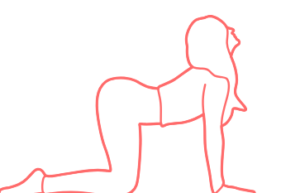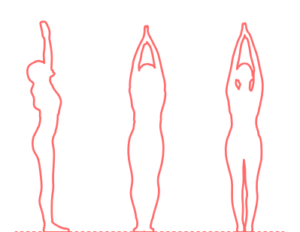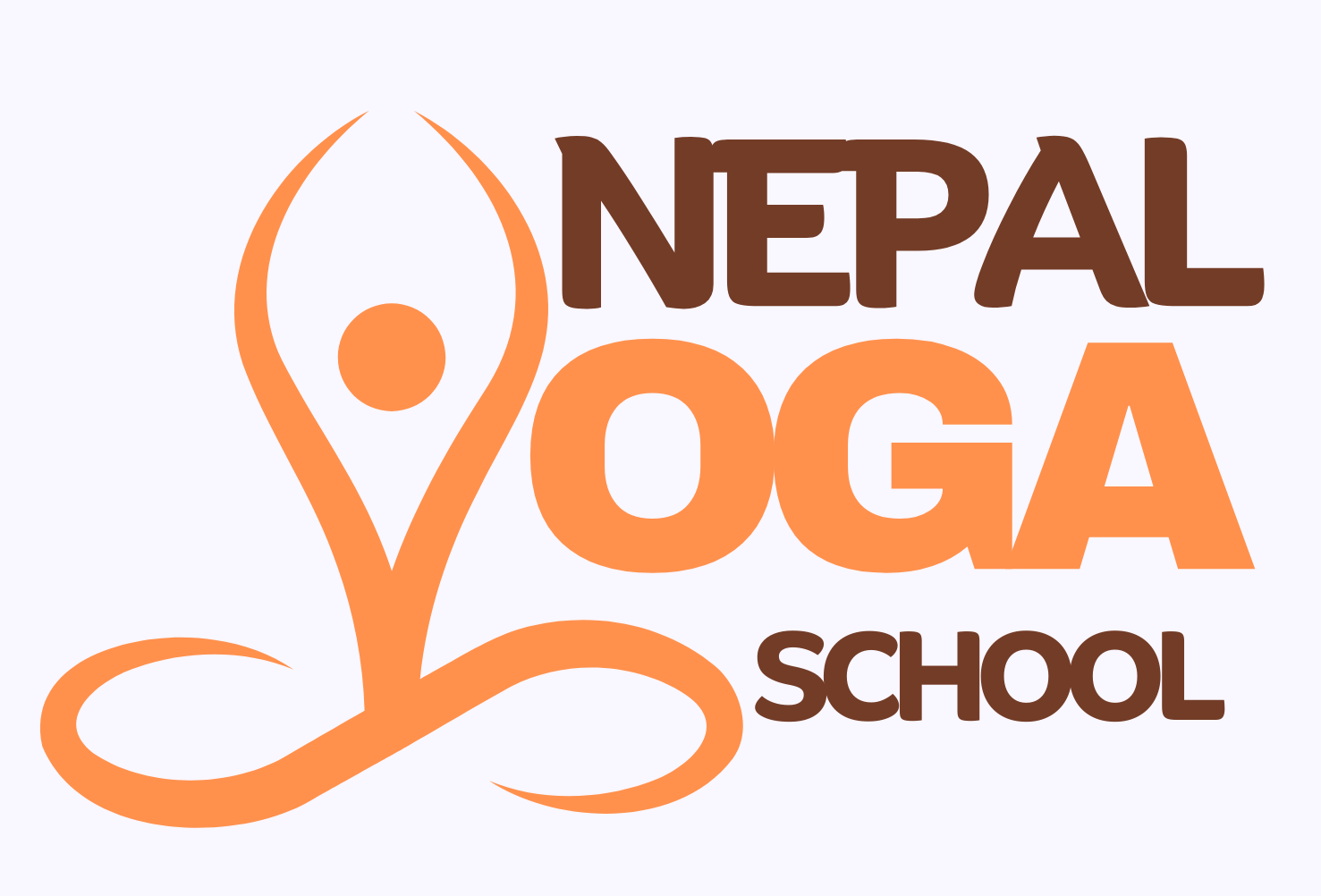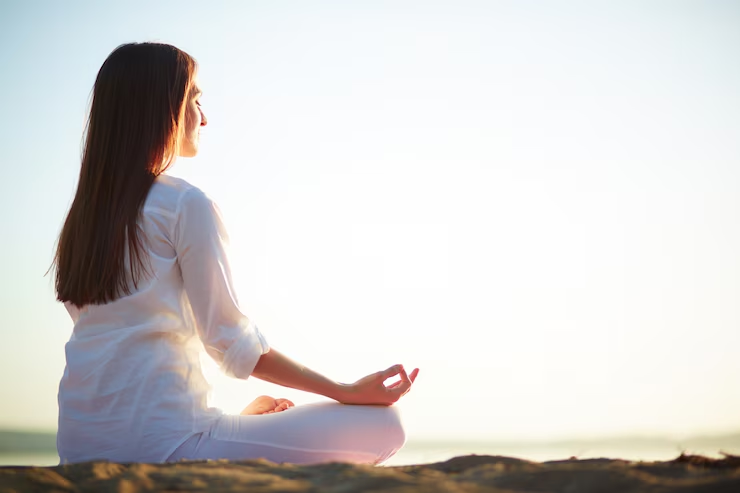A Morning Yoga Routine is a great way to kick start a day with a positive mindset and keep a person energized and centered. A gentle series of breathwork, stretching, and mindfulness to fuel your morning. For beginners, workouts can be a little heavy so designed for all levels, the Yoga practice can be completed in just 15-20 minutes.
Morning Yoga Routine
- Child’s Pose (Balasana)

Incorporating Child’s Pose in a Morning Yoga Routine helps stretch the spine . This Yoga pose is basic and gentle. In any yoga session, this pose is something to return to when needed to recharge or rest.
Breathe in and bring your big toes together behind you while standing at a table. Next, take a seat on your heels and spread your knees to make room beneath you. If it’s more comfortable, you can also decide to keep your knees together.
Exhale, bringing your upper body forward and your hips back so that your torso rests between or on top of your thighs. Spread your knees apart if you feel a pinching sensation in your hips when your knees are together. Extend your arms ahead of you, extending as far as possible. After 1-2 minutes of this Yoga pose, the body will feel a lot better.
- Cat-Cow Pose (Marjaryasana-Bitilasana)


Cat-Cow Pose also known as Marjaryasana-Bitilasana is an effective pose for a Morning Yoga Routine as this is a good pose to help improve flexibility and mobility in the spine. Take a kneeling tabletop position, resting your knees hip-distance apart precisely behind your hips and your hands shoulder-width apart.
As you inhale, raise your head and chest so that you are staring skyward, ease your belly towards the floor, and arch your back into a cow stance. Then release your breath, draw your tummy in, and round your back into a cat stance as you exhale.
Feel your neck and spine stretch in both directions as you switch back and forth between these two poses as much as you’d like. You are welcome to move your head, shoulders, or hips in a gentle circular motion while taking calm, deep breaths.
- Reclining Twist (Supta Matsyendrasana)
Depending on your level of flexibility and the area of your spine you choose to work on, there are various methods to add this pose to the Morning Yoga Routine. Initially, assume a prone position and raise your legs towards your chest.
Put your right hand on your left knee and give yourself a hug. Lay your left arm outstretched and flat on the ground next to you. Exhale, twisting from the centre, and gently bring your bowed legs down to the right side of your body.
Till your hips and back start to stretch, lower your knees to the floor. Next, glance to your left hand with your head turned. Return to the centre on an inhalation and then move to the opposite side.
Your shoulders and chest can lift up, and you may feel a slight stretching in your hips, buttocks, and back. You can also lie on your right side with your legs bent and lying on top of each other for a softer stretch or to specifically target the upper spine. Subsequently, steadily rotate your upper body left. Next, extend the opposing side.
- Upward Salute (Urdhva Hastasana)

For the Upward Salute, place your feet hip-distance apart while standing. As you move your hips slightly forward and feel your feet making contact with the floor, keep your core active. Extend your arms slowly upward, such that they are shoulder-distance apart and in line with your ears. Next, raise your palms towards one another and, if you are able, make contact. Feel the stretch in your arms and neck as you raise your gaze to your hands.
You can attempt to stand up on your toes if you so choose. As you inhale deeply, locate your centre. When you’re ready, release the pose by lowering your arms and the rest of your body gradually. Shake out your arms and legs for a few minutes to let go of any residual tension. Adding the Urdhva Hastasana in Morning Yoga Routine, helps to engage the abdominal and core muscles and thereby strengthen them moderately.
- Half Cobra (Ardha Bhujangasana)

Half Cobra Pose also known as the Sphinx Posture as it resembles the Egyptian Sphinx, is a must pose for the Morning Yoga Routine, it enhances flexibility and removes body stiffness. For this pose, let go of your legs and roll onto your chest so that your cheek or forehead touches the ground. Keeping your elbows tightly flexed against your sides, rest your forearms and position your hands precisely beneath your shoulders on the ground.
After that, raise your forehead and torso and gently push away from the floor. As you continue to breathe softly in through your nose and out through your mouth, feel your spine gently stretching. Take three deep breaths here.
- Seated Forward Bend (Paschimottanasana)

The Morning Yoga Routine pose known as Paschimottanasana, your entire back, including your spine, is stretched to the limit. A sitting forward bend in yoga is achieved by stretching both legs straight out on the floor, laying the forehead on the knees, and gripping the big toes with the hands.
Sit on the floor with your legs out straight in front of you to begin. Lay your hands beside your hips on the ground. Exhale and reach out your hands to catch your big toes. Place your left hand between your thumb and index and middle finger of that hand, and your right hand between your right toe and your left hand. Lean forward, stretch your spine, and keep your back in a concave position. Bend and spread your elbows, using them as levers, as you release the breath. Pull the trunk forward gently and make an effort to touch the knees to the forehead. The ideal position for beginners is to bend their knees until their foreheads are comfortably in contact with them. Put your elbows down now.
Conclusion
Having a regular Morning Yoga Routine at first is about being sincere. Later on, the body will feel the changes and the improvement coursing through it as incorporating the routine becomes a habit.

